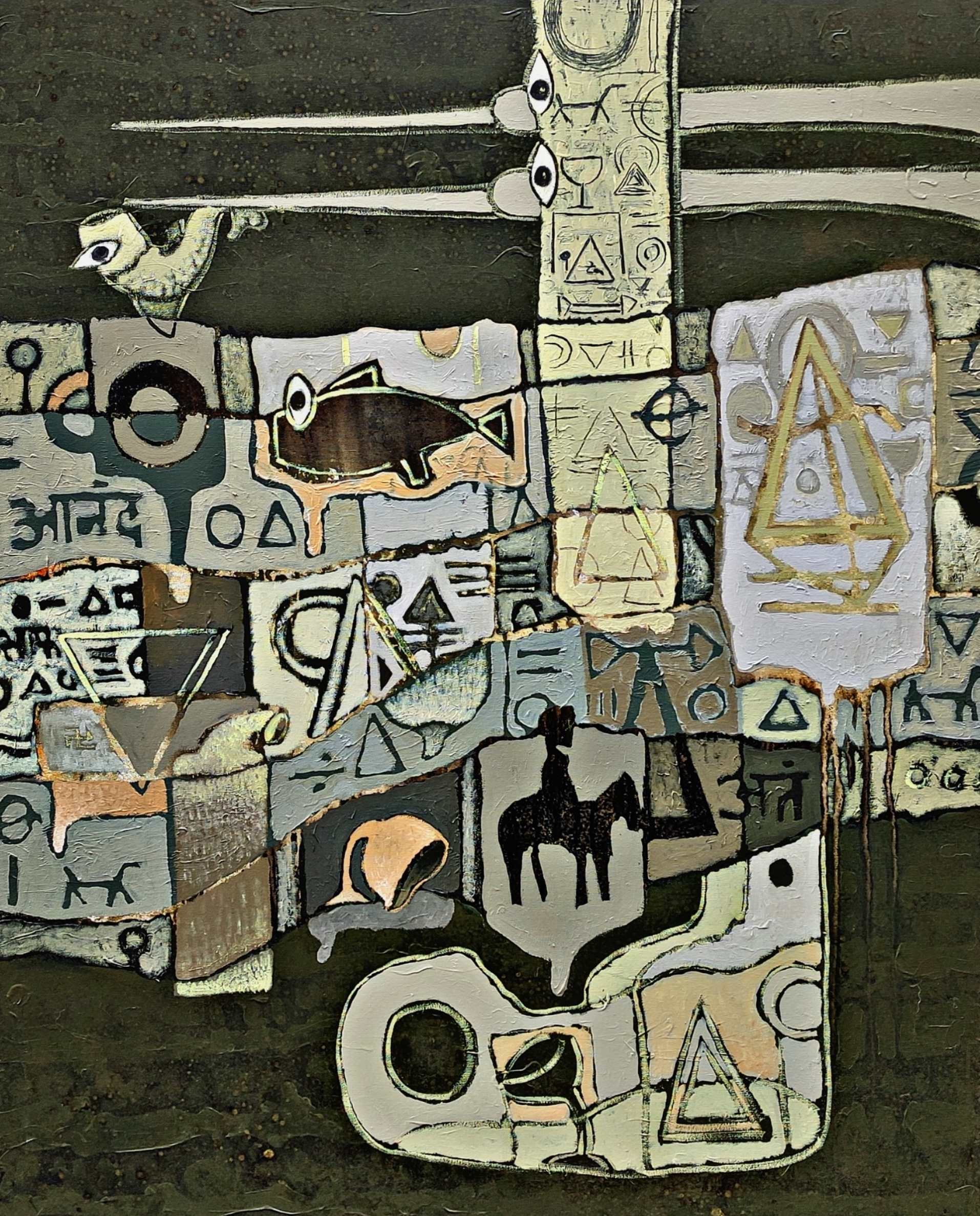#InConversation with Aditya Singh Rajpoot
By Davangi Pathak | Aug 8 2024 · 10-15 mins
Based in Jabalpur, Aditya works in a studio space that is approximately 100 years old. This historic studio plays a crucial role in his practice, serving as the birthplace of his creative thoughts. In this interaction, we will delve into Aditya's artistic journey, which began with figurative work and is now evolving towards abstraction.
Davangi: Your compositions are richly layered, beginning with experimentation. How do you determine the point at which to stop layering?
Aditya: I have been working with the layering process since my college days, and it has been nearly eight years since I began using this technique. Over time, I have developed a deep connection with my paintings, understanding the demands of my compositions and the nature of the layers involved. This process is not rigid; it varies based on when I am composing. Decisions about which parts to retain or discard depend on the composition itself, guiding how the layers are advanced and when to pause.
Davangi: The scripture and texts you incorporate into your paintings are intriguing. Could you explain their significance and origins?
Aditya: Texts play a crucial role in my paintings, where I incorporate words as integral elements of my compositions. The text you see is deeply influenced by the concept I am working on at the time and the thoughts that arise during the creative process. These thoughts are then woven into the composition. The presence of words extends from the first layer to the final one, creating a pervasive dialogue within the artwork. Words surround us, shaping our interactions and thoughts, much like how they influence my paintings. I view the painting process as a conversation, with words impacting the work in various ways. Additionally, I incorporate geometric forms into my paintings, as they can convey significant meaning with minimal lines.
Davangi: How do you select your colour palette? Are there specific criteria you consider while choosing colours?
Aditya: In my earlier compositions, I used a range of vibrant colours. However, as my work evolved, I gradually reduced the colours in my palette, and it has now become predominantly monochrome. I discovered that a monochrome palette allows me to explore light and depth more effectively, while also imparting a sense of tranquillity and simplicity to my work.
Davangi: Forms like horses, fish, eyes, wine glasses, and triangles frequently appear in your paintings. Could you elaborate on their significance?
Aditya: In my work, forms and symbols are imbued with hidden stories. The horse, for instance, symbolises life's journey, representing the span from birth to death. The fish reflects the fickleness of the mind. I express my emotions through bottles of wine and wine glasses, which embody both joy and sorrow. Eyes serve as a central element in my paintings. They mirror many aspects of our lives and reveal a person's personality. In our surroundings, eyes—both literal and metaphorical—observe and monitor us, often constraining our freedom of thought. This societal gaze can evoke both a sense of beauty and an undercurrent of fear. The geometric forms I use, such as triangles and circles, often represent male and female energies and their attraction. The interplay between ascending and descending triangles symbolises the essence of life and together embodies the concept of Ardhanarishvara. All these elements are integral to my compositions, each contributing to the overall harmony and meaning of the work.
Davangi: Are there any artists, their methodologies, or aspects of their lives that serve as inspiration for you?
Aditya: Brijmohan Arya, a contemporary artist and my mentor, has significantly influenced my work since my college days. I frequently visited his studio, where I observed his innovative approach to painting. What impressed me most was his unique application of colour and his use of novel tools. Additionally, residing in the Gondwana region, where the Gond tribes live, has profoundly impacted me. The tribal artists and their techniques have also left a lasting impression on my work.
Davangi: Could you discuss the painting techniques and applications you have developed throughout your practice?
Aditya: When discussing my technique, I favour working layer by layer, employing multiple layers in my artwork. Through continuous practice, my methods have naturally evolved to incorporate this layering approach. Although this technique is somewhat time-consuming, I find it immensely satisfying. Additionally, my extensive sketching and watercolour practice have also influenced my work, leaving a lasting impact on my overall technique.
Davangi: Would you like to discuss any upcoming projects? Do you plan to experiment with different mediums in your future work?
Aditya: Indeed, I have numerous plans for the future, and they continually evolve. I am currently exploring a new medium and have begun experimenting with it. For instance, while my paintings often evoke a mural effect, I initially attempted to achieve this with terracotta but found it challenging to master. I am now working with fabric and plan to return to terracotta in the future. Regarding my concepts, they are also undergoing significant changes, and you will gradually see these developments in my upcoming projects.
Click here to view Aditya's Online Viewing Room and learn more about his practice.


